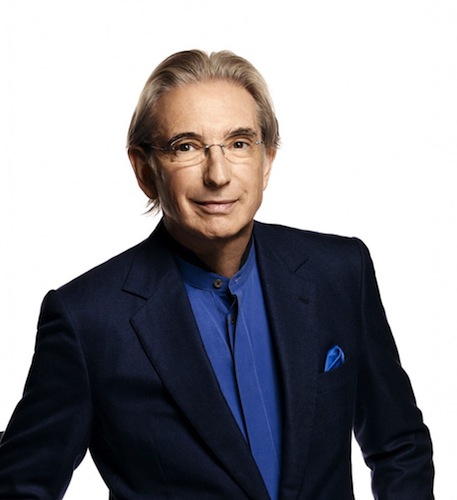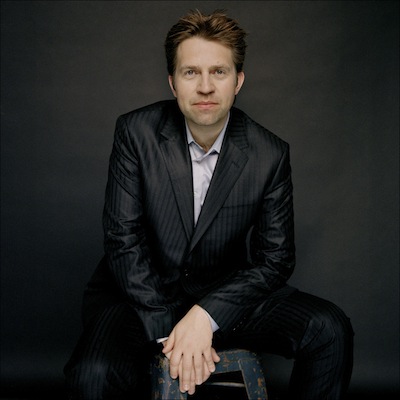MTT, New World brilliantly showcase a full-plumage “Firebird”

Michael Tilson Thomas conducted the New World Symphony in music of Debussy and Stravinsky Saturday night at New World Center.
The music of Igor Stravinsky has always brought out the best in Michael Tilson Thomas and the conductor was in prime form on Saturday night, leading the New World Symphony in early and middle period Stravinsky scores.
Prior to the commencement of the concert, Tilson Thomas asked the audience at the New World Center in Miami Beach to stand for a moment of silence in memory of the victims of the school shooting on Friday in Parkland. (The names and ages of the victims were projected on the hall’s video screens.)
Turning to Stravinsky’s Scènes de ballet, Tilson Thomas noted that his composition teacher Ingolf Dahl helped the busy Stravinsky complete the work in time for its Broadway premiere in December, 1944. He added that he too was busy at that time getting ready to be born (which happened later that month.) Scènes de ballet represents the populist side of Stravinsky, just as the jazz suites and film scores of Shostakovich demonstrate a lighter side of that composer.
Originally composed for the revue “The Seven Lively Arts” (which also featured songs by Cole Porter and performances by Bert Lahr and Beatrice Lillie), the 18-minute divertissement runs the gamut from Tchaikovsky inflected dance melody to a parody of the cowboy tunes of the era. Along the way there are sly references to Gershwin’s “The Man I Love” and Stravinsky’s own Petrushka. With touches of Stravinsky’s neo-classical style from that era and repeated opening and closing chords of mock pomposity, the work radiates considerable wit and charm. The score was a great showcase to display every section of the New World at top strength and Tilson Thomas conducted it with idiomatic flair.
While Stravinsky’s Broadway concoction occasionally appears on concert programs, Debussy’s Fantaisie for piano and orchestra is a seldom-performed rarity. Debussy completed the work in 1890 but withdrew the score prior to the scheduled premiere, revising it repeatedly over several decades but refusing to allow publication or performance. It was finally premiered in 1919, a year after Debussy’s death) but not published in complete form until 1968. This work is as close as Debussy came to writing a piano concerto and it demands a soloist with formidable technique and musicianship.
The Norwegian pianist Leif Ove Andsnes is that and more. Andsnes is an artist who puts a distinctive stamp on everything he plays. And the Debussy Fantasie needs that kind of artistic salesman to make it work.
While the score is not an unforgettable masterpiece, it deserves to be played more often. The opening oboe solo of the first movement suggests typical Debussy impressionistic languor but the music soon morphs into a more romantic vein. The fleet-fingered Andsnes conveyed a full range of pianistic colors. A master at sweeping, big-boned whirls of melody and pyrotechnics, he played the Rachmaninoff-like sections at full power. In this stylistic mélange, Tilson Thomas drew opulent playing and brought out Debussy’s kaleidoscopic instrumental timbres.
The Lento and Allegro molto finale sound more like Ravel, Debussy’s contemporary. Andsnes’ bursts of tonal heft brought some clarity to the wispy theme of the slow movement (with two harps adding to the orchestral shimmer). The finale is jazzy in the manner of the last movement of Ravel’s Concerto in G Major, written three decades later. Jazz had not even been conceived as a popular art form in the late nineteenth century so Debussy was literally inventing a musical language. Andsnes attacked this final showpiece with virtuosity but also displayed a sensitive touch in a central episode that could have come right out of Debussy’s Preludes.
A cheering ovation brought Andsnes back for an encore ” Doctor Gradus ad Parnassum” from Debussy’s Children’s Corner Suite. Vigorous, fistfuls of notes and hand crossings at the outset gave way to pearly toned elegance in the lyrical episode. Andsnes’ gradual buildup of the final crescendo was masterful, keeping the pulse and avoiding bombast. This terrific pianist needs to be heard more often in South Florida.
The suite from Stravinsky’s The Firebird is a concert staple but Tilson Thomas chose to play the complete ballet score in the original 1910 version. With a doubled number of winds, no less than three harps and extra brass on the hall’s terraces and rear, the performance was an exciting display of the orchestra’s firepower and the auditorium’s splendid acoustic.
From the barely audible rumbles of the seven basses in the first bars to the blazing finale, Tilson Thomas emphasized a wide sonic palette with sharp contrasts of tempo and dynamics. Fast sections were very fast. Yet Tilson Thomas’s conception lso returned the dance to this ballet score. “The Dance of the Firebird” had an edginess that differed from more sedate versions. Strings played with a dark tonal cast and the large wind contingent was outstanding. Special kudos to Elizabeth Lu’s solo flute which was agile, exquisite and bright in perfect balance.
Tilson Thomas brought out the violence of the “Infernal Dance” in brisk strokes with high contrasts of timbres leaping forth from the ensemble. The big climaxes were augmented by hard-driving percussive whacks and brass eruptions from around the hall. The warm tone of Brenton Foster’s bassoon set the stately pace of the “Lullaby.” Here Tilson Thomas drew out the music’s romantic Russian roots and its indebtedness to Rimsky-Korsakov, Stravinsky’s teacher. The gradual coalescing of the principal theme of the finale was thrilling with the conclusion perhaps setting a new decibel level for an orchestral performance at the New World Center.
All credit to Tilson Thomas for presenting The Firebird as Stravinsky first conceived it in a performance that brought out the music’s richness and originality with such striking brilliance.
The New World Symphony repeats the program 2 p.m. Sunday at the New World Center in Miami Beach. nws.org 305-673-3331
Posted in Performances
2 Responses to “MTT, New World brilliantly showcase a full-plumage “Firebird””
Leave a Comment
Sun Feb 18, 2018
at 12:00 pm
2 Comments








Posted Feb 19, 2018 at 1:00 pm by Hubert Harriman
I heard the performance on Sunday, and it was one of the greatest listening experiences of my (long) life. Almost as thrilling as Bernstein conducting the Rite of Spring with the NY Phil.
Posted Feb 27, 2018 at 2:31 am by felixdorn
By Lawrence Budmen, thanks for the article post.Really thank you! Great.